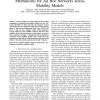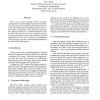COMSUR
2011
13 years 2 months ago
2011
—In large networks, a data source may not reach the intended sink in a single hop, thereby requiring the traffic to be routed via multiple hops. An optimized choice of such rout...
COMCOM
2004
14 years 2 months ago
2004
The Differentiated Services (DiffServ) architecture has been proposed by the Internet Engineering Task Force as a scalable solution for providing end-to-end Quality of Service (Qo...
JNW
2006
14 years 2 months ago
2006
There is being an on-going effort in the research community to efficiently interconnect Mobile Ad hoc Networks (MANET) to fixed ones like the Internet. Several approaches have been...
CORR
2006
Springer
14 years 2 months ago
2006
Springer
In this paper new, lightweight security and control protocol for Voice over Internet Protocol (VoIP) service is presented. It is the alternative for the IETF's (Internet Engi...
CN
2010
14 years 2 months ago
2010
Overload in a packet-based network can be prevented by admitting or blocking new flows depending on its load conditions. However, overload can occur in spite of admission control ...
IMC
2007
ACM
14 years 3 months ago
2007
ACM
As the utility of wireless technology grows, wireless networks are being deployed in more widely varying conditions. The monitoring of these networks continues to reveal key imple...
INTERWORKING
2000
14 years 5 months ago
2000
The Internet Engineering Task Force (IETF) is currently working on the development of Differentiated Services (DiffServ). DiffServ seems to be a promising technology for next-gene...
NDSS
1997
IEEE
14 years 6 months ago
1997
IEEE
The Internet Engineering Task Force (IETF) is in the process of adopting standards for IP-layer encryption and authentication (IPSEC). We describe how “probable plaintext” can...
ISCC
2003
IEEE
14 years 7 months ago
2003
IEEE
Mobile IPv6 (MIPv6) and Fast Handover (FHO) have been developed by the Internet Engineering Task Force (IETF) to address the IP mobility issues of roaming mobile devices, and to r...
SAINT
2005
IEEE
14 years 7 months ago
2005
IEEE
IPv6 is now a mature standard, with the core protocols defined by the Internet Engineering Task Force (IETF). Over the past two years a number of national research networks and a...




